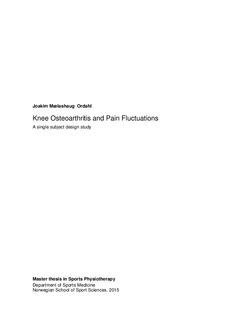| dc.description.abstract | Background: Osteoarthritis is one of the most common chronic pain disorders, pain is
the dominant symptom, and exercise is one of the key elements in the conservative
management. The nature of pain in osteoarthritis patients has earlier been considered
relatively stable. However, this view of pain is challenged in the literature.
Objective: To evaluate pain fluctuations over time among middle-aged patients with
mild to moderate knee osteoarthritis undergoing a 14-week exercise intervention.
Material and Methods: This study was part of a randomized controlled trial (Oiestad
et al., 2013) investigating the efficacy of strength and aerobic exercise in middle-aged
patients with knee osteoarthritis. Eleven knee osteoarthritis patients were followed in
this single subject design study. During a 16 week period (1 week baseline + 14 week
intervention + 1 week post intervention) patients were regularly (assessments daily
during the baseline phase and the post intervention phase, weekly during the
intervention phase) assessed with the pain subscale of the Knee Osteoarthritis Outcome
score (KOOS) and the Numeric Rating Scale (NRS) for pain.
Results: The mean fluctuation (difference between the highest score and the lowest)
during the intervention phase was 28 points measured with the KOOS pain and 7 points
measured with the NRS for pain. Comparing with the post intervention phase, pain
fluctuation measured with the KOOS pain was higher during the intervention phase for
all subjects except one. Measured with the NRS for pain, all subjects had higher pain
fluctuation during the intervention phase compared to the post intervention phase.
Comparing the post intervention phase with the baseline phase, all but two subjects had
higher pain fluctuations at the baseline phase compared to the post intervention phase
measured with the KOOS pain. Measured with the NRS for pain, all but one subject had
higher pain fluctuations at the baseline phase compared to the post intervention phase.
Conclusion: This study showed that overall, according to a cutoff of ten points for the
KOOS pain and two points for the NRS for pain patients with knee osteoarthritis
reported clinically meaningful (MCID) pain fluctuations during a 14-week intervention
period. Pain fluctuations varied substantially among the eleven subjects. In general, pain
fluctuated less at the post intervention phase compared to the baseline phase and the
intervention phase. The results from this study add to the literature documenting pain
fluctuations in patients with knee osteoarthritis. | nb_NO |
